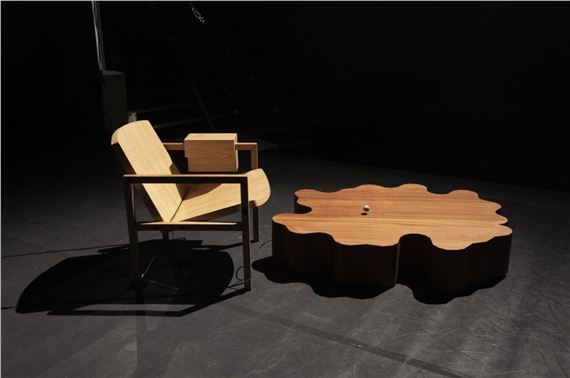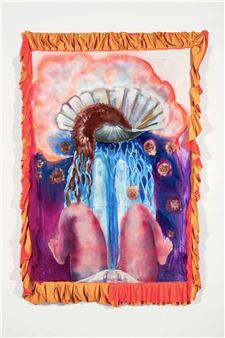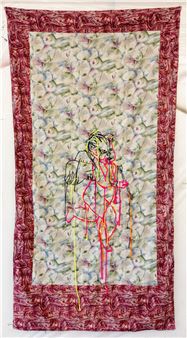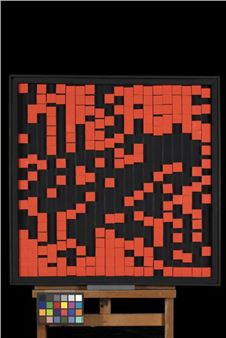After First, Comes Second
The sculptures you are going to see in this exhibition are not monumental, nor are they necessarily vertical and permanent. They are not bothered with the originality of the material and artistic gesture, as sculpture is usually defined. Sculptures of the presented artists, who live or work in Split, Rijeka, Ljubljana and Zagreb, zigzag through various media – from light, movement and text to video and ready-made. They occupy the space from the Benčić courtyard, including its walled stream and the Museum’s facade, to the Museum’s interior.
Dedicated to the exploration of the boundaries between balance and body control, these works do not offer stability – instead, they work with instability. Standing in opposition to the imposed culture of individualism and self-sufficiency, these works make us wonder: how do we deal with the body in today’s age? How can we, instead of using representative models, draw attention to its imbalance and its daily struggles with limitations? How can we, using nonverbal communication, say that we have fallen out of balance, and now have to continue without it?
Instead of offering a single narrative, direct messages and overt social engagement, these works reflect on our entanglement in multiple crises that impose the forms of creation, but also encourage the attempts to get away from rigid manners of functioning. Gaia Radić evokes sculpture as an ancient being emerging from the substructure of space – the stream in the Benčić courtyard. Vedran Perkov uses text and light as uncertain forms of self-help and places them on the museum façade, where each sentence vibrates between banality and urgency.
In the works of Igor Ruf, sculptures oscillate between discarded and newly designated spaces, between the desired and the real, while high culture shifts into its own everyday context, where absurdity is the central component. Sara Salamon creates an additional space that “pretends to be part of the existing one” – a false vertical, a spatial glitch. Tanja Vujasinović reaches for the Museum’s collection, and reinterprets a thought by Ivan Kožarić through a light sculpture. In this work, “A bit of spirit, a bit of matter” does not contain contradictory concepts, but denotes the simultaneity of circumstances. Viktor Popović presents the Museum’s archives as a mechanism of oblivion – as a construct where light eerily slows down our gaze. In the installation of Vlasta Žanić, we encounter a never-ending loop, a collage of personal notes, discarded materials and archival traces. The installation becomes an architecture of invisible processes – journal entries, emotional slow-down, re-examination. Kristian Kožul re-assembles disassembled bodies, as prosthetics that do not hide the vulnerability, but make it visible instead. In terms of media and sculpture, the individual and the collective, but also in terms of institutionality, these works examine and reinterpret the inert and postponed functions and raise some questions: what does it mean to stand up? Who has to be excluded in order for something to take place? Where is the burden and where is the relief?
Instead of perfectionism, permanent and stable forms, and eternity as a value-driven obsession of (museum) institutions, this exhibition explores fragility, vulnerability, and imbalance as the way of restoring balance. Instead of celebrating the cult of the new and the chase for a previously unattainable standard, where gratification is often deferred, it is interested in processes of repairing objects and re-tuning subjects. Along with imperfect corporeality, the exhibition’s vocabulary includes the search for non-hierarchical models of connection and organization, which releases suppressed energies and angst through play, experimentation, and humor. The exhibition title itself testifies to this, shifting the focus away from the achievements of champions, leaders, rulers, but also from the image of artists and curators as mystical creators who make things out of thin air, onto the everyday fabric of life, woven through reciprocity and often invisible support.

Recommended for you
The sculptures you are going to see in this exhibition are not monumental, nor are they necessarily vertical and permanent. They are not bothered with the originality of the material and artistic gesture, as sculpture is usually defined. Sculptures of the presented artists, who live or work in Split, Rijeka, Ljubljana and Zagreb, zigzag through various media – from light, movement and text to video and ready-made. They occupy the space from the Benčić courtyard, including its walled stream and the Museum’s facade, to the Museum’s interior.
Dedicated to the exploration of the boundaries between balance and body control, these works do not offer stability – instead, they work with instability. Standing in opposition to the imposed culture of individualism and self-sufficiency, these works make us wonder: how do we deal with the body in today’s age? How can we, instead of using representative models, draw attention to its imbalance and its daily struggles with limitations? How can we, using nonverbal communication, say that we have fallen out of balance, and now have to continue without it?
Instead of offering a single narrative, direct messages and overt social engagement, these works reflect on our entanglement in multiple crises that impose the forms of creation, but also encourage the attempts to get away from rigid manners of functioning. Gaia Radić evokes sculpture as an ancient being emerging from the substructure of space – the stream in the Benčić courtyard. Vedran Perkov uses text and light as uncertain forms of self-help and places them on the museum façade, where each sentence vibrates between banality and urgency.
In the works of Igor Ruf, sculptures oscillate between discarded and newly designated spaces, between the desired and the real, while high culture shifts into its own everyday context, where absurdity is the central component. Sara Salamon creates an additional space that “pretends to be part of the existing one” – a false vertical, a spatial glitch. Tanja Vujasinović reaches for the Museum’s collection, and reinterprets a thought by Ivan Kožarić through a light sculpture. In this work, “A bit of spirit, a bit of matter” does not contain contradictory concepts, but denotes the simultaneity of circumstances. Viktor Popović presents the Museum’s archives as a mechanism of oblivion – as a construct where light eerily slows down our gaze. In the installation of Vlasta Žanić, we encounter a never-ending loop, a collage of personal notes, discarded materials and archival traces. The installation becomes an architecture of invisible processes – journal entries, emotional slow-down, re-examination. Kristian Kožul re-assembles disassembled bodies, as prosthetics that do not hide the vulnerability, but make it visible instead. In terms of media and sculpture, the individual and the collective, but also in terms of institutionality, these works examine and reinterpret the inert and postponed functions and raise some questions: what does it mean to stand up? Who has to be excluded in order for something to take place? Where is the burden and where is the relief?
Instead of perfectionism, permanent and stable forms, and eternity as a value-driven obsession of (museum) institutions, this exhibition explores fragility, vulnerability, and imbalance as the way of restoring balance. Instead of celebrating the cult of the new and the chase for a previously unattainable standard, where gratification is often deferred, it is interested in processes of repairing objects and re-tuning subjects. Along with imperfect corporeality, the exhibition’s vocabulary includes the search for non-hierarchical models of connection and organization, which releases suppressed energies and angst through play, experimentation, and humor. The exhibition title itself testifies to this, shifting the focus away from the achievements of champions, leaders, rulers, but also from the image of artists and curators as mystical creators who make things out of thin air, onto the everyday fabric of life, woven through reciprocity and often invisible support.
Contact details


 ARTISTS
ARTISTS












